Disclosure: Meeple Mountain received a free copy of this product in exchange for an honest, unbiased review. This review is not intended to be an endorsement.
Pyramid Arcade is a monster collection of boards, dice, cards, and pyramids. It is the result of over 25 years worth of work from Andy Looney, the man behind not only the Pyramid games, but Fluxx and Chrononauts. Inside the box you’ll find everything you need to play all 22 games written up in the 80-page rule book. Don’t let the length put you off, though — most games are only a page or two long and can be learned in as many minutes.
Hi, I’m Avatar Tom and I’ll be poking my head in to make the occasional comment or observation. For instance, in the rule book, Andy Looney, the man who created the Pyramids and the majority of these games, calls Pyramid Arcade his “magnum opus.” I think that’s an accurate statement.
There is a lot to, um, unbox here, so let me explain what all of this is before getting into the games themselves.
Components and Terminology
Before we begin exploring the games, you need to be familiar with some of the many components inside the box and how they are referred to in the different games.
Pyramids
Pyramids are the primary playing pieces of the Pyramid Arcade, the Arcade’s heart and soul. The Pyramids come in three sizes: Small, Medium, and Large.
A group of three Pyramids, one of each size, is referred to as a Trio. Pyramids can be stacked either largest covering the Medium which is covering the smallest to become a Nest. When stacked largest on the bottom, Medium atop that, and the smallest crowning the stack it is known as a Tree.
The game comes with 90 Pyramids in 10 colors: Red, Orange, Yellow, Green, Cyan, Blue, Purple, Clear, Black, and White. A monochrome Trio is a set of three of the same color; a mixed-color Trio is three Pyramids of different colors.
As well, orientation is important in some games: a Pyramid standing up is considered Upright; laying down a Pyramid is considered to be Flat.

Pips
The Pyramids are not only distinguishable by their three sizes, but also by the number of indentations at their base — or Pips. Small Pyramids have one pip, Mediums two, and Larges three. The pips are used to keep score in some games, while others use the numbers instead of sizes.

Dice
Many of the games in Pyramid Arcade rely on dice to determine the moves possible on a given turn. Pyramid Arcade comes with six different types of six-sided dice. The three standard dice with pips 1-6 on their faces will be familiar. The three Lightning Dice will be less so. There’s also a Color die with the colored symbols used in the five-suited deck of Zark City Cards (see below); the Pyramid die depicting different Pyramid sizes on each face; and the Treehouse die with different words on each side.
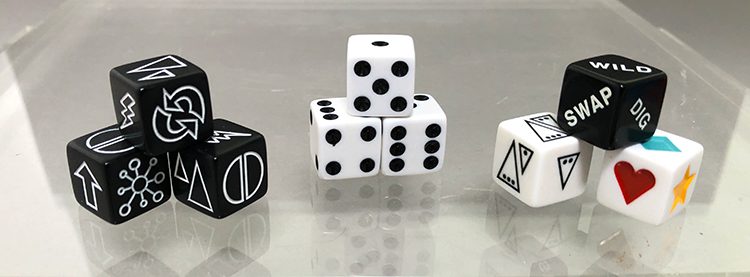
Cards
There are three sets of cards in the Arcade. A tiny set of cards with Twin Win on the back are used as secret winning conditions in the game of the same name; Zark City Cards are the 65 card, five-suited square deck used in the game of the same name as well as Verticality (another game); a set of Arcade Cards provides one card for each game with a very quick run-down of what the game involves, the number of players and how long it takes to play and the level of difficulty. These can be used to randomize what games within the Arcade you play should you have trouble deciding.
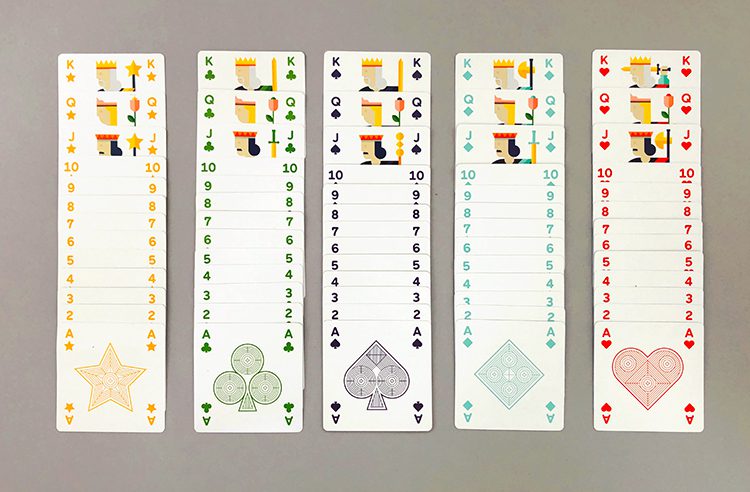
Boards
Not all games in Pyramid Arcade require game boards.There is a set of smaller, double-sided cardboard boards (both square and round) for certain games. A larger, double-sided fold-out board is used for two games (one per side), and a pair of white, hard plastic, grooved trays (known as The Wheel and Volcano Board) are used for other games.
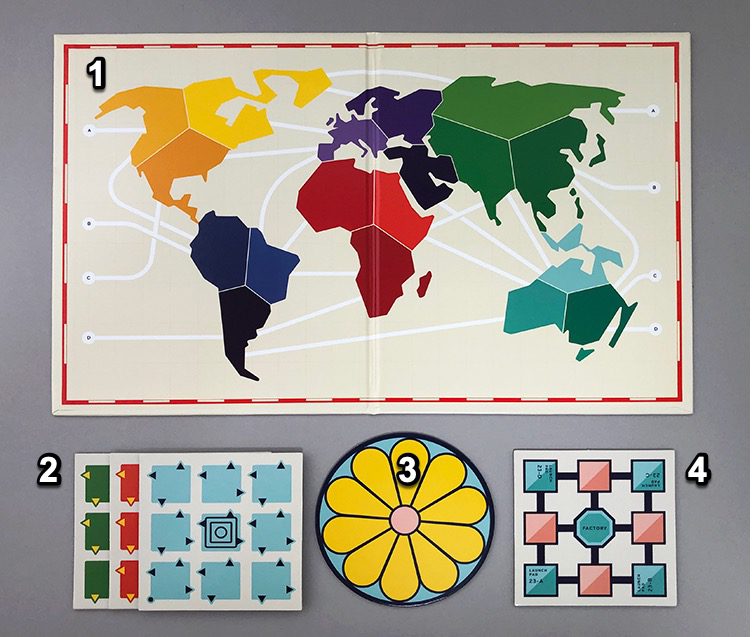
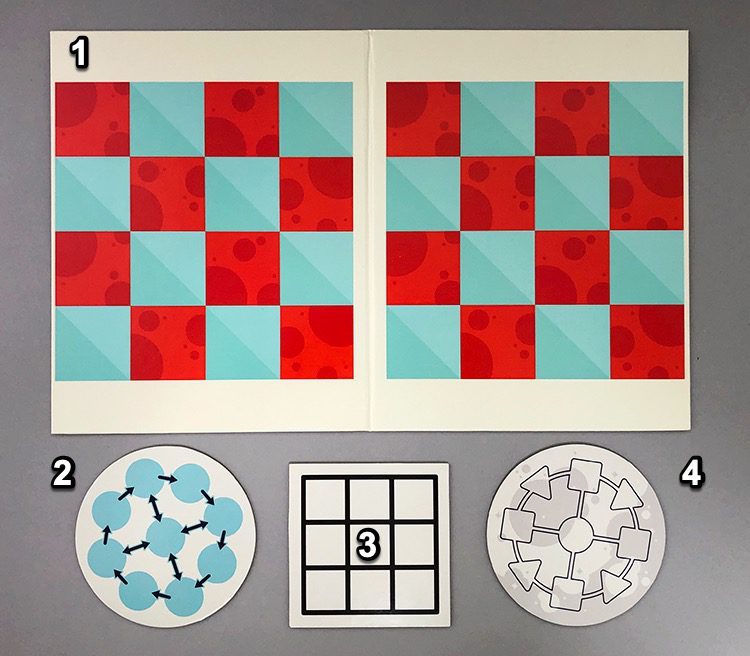
The Bag & The My Turn Coin
There are several games that require you to draw Pyramids at random for your game. The fine folks at Looney Labs have included a large drawstring bag just for such occasions.
And should you need help in remembering whose turn it is, a shiny Pyramid Arcade “It’s My Turn” coin is included.
With 22 games in Pyramid Arcade, how do you know which games to start with? We asked ourselves the same question and have decided to help you out by creating a drop-down list of games based on the number of players you’re looking to play with. Some games in Pyramid Arcade can be played solo, while others can be played with up to ten people. Most fall into the 2-6 player range and scale up or down well.
Of course, if you’d like to just dive in and read about each game or scroll down until you see a photo of a game setup that looks intriguing, just keep on scrolling!
Black ICE
Components: Three Trios of five colors (one of which must be black), drawstring bag, three Lightning dice
Number of Players: 2
Black ICE is a hidden ‘code’ game with players each trying to learn the color combination of the Pyramids hidden underneath three black Pyramids before their opponent does.
The game starts with three black Large Pyramids, known as ‘Locks’, situated in a row between the two players. One player ‘sets the code’ by taking each Lock in turn and placing it into the bag of Pyramids, then placing a single Small Pyramid inside. At the start of the game, neither player will know what pyramids are hidden in the Locks. When all three Locks have been returned to the table, play starts.
On a turn, players roll the three Lightning dice. Depending on what is rolled, players may:
- Peek under one of the Locks to learn what color Small is hidden underneath.
- Set a colored Pyramid on your side of one of the Large blacks. This becomes your Guess when you try to unlock the code
- Swap out the positions of any two Locks (and the colored Smalls underneath).
- Reset one of the Locks by lifting the Lock and taking it and the colored Small Pyramid that was underneath and placing them into the bag. Drop the former Small Pyramid and choose another one, setting the Lock back on the table so it remains unseen by all.
- Copy an opponent’s action by mimicking their guess.
- Wild — or your choice of any of the other moves.
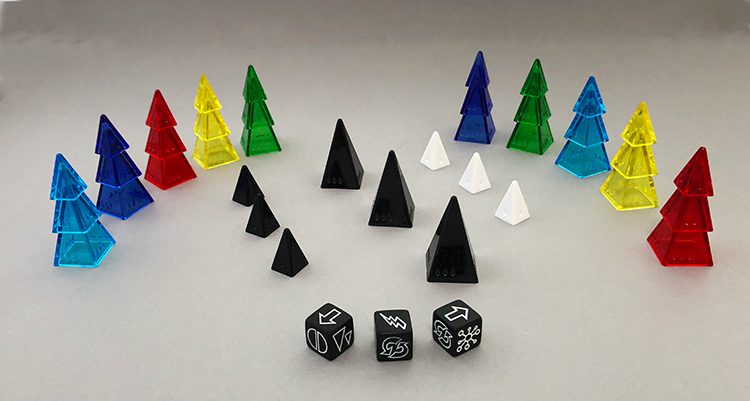
The rules for Black ICE call for three hidden codes, typically using the opaque Black Pyramids to cover the hidden ‘code’ Pyramids. However, if you find that three ‘code’ Pyramids makes for too easy of a game you can expand the game. Just add in 1-3 of the opaque White Pyramids for a more complex, longer game.
Color Wheel
Components: All 90 Pyramids, the Wheel board
Number of Players: 1-5
This is a fun puzzle game that needs to be completed within a set number of moves.
Set the Clear, White, and Black Pyramids on their side, off to the side of the Wheel board. These 27 Pyramids will be used as counters — meaning you’ll have 27 moves to complete the puzzle.
Take all of the Pyramids in the colors of the rainbow and place them in the drawstring bag and give it a good series of shakes to mix them up. Draw out Pyramids and place them laying down in the spaces on the Wheel board, making certain to not have Pyramids of the same color touching sides and that you’ve used all three Pyramid sizes for each color.
The goal is to get all of your Pyramids grouped together by color. On each turn, you’ll either swap places with Pyramids of the same size or the same color. With each turn, stand one of the counter Pyramids up.

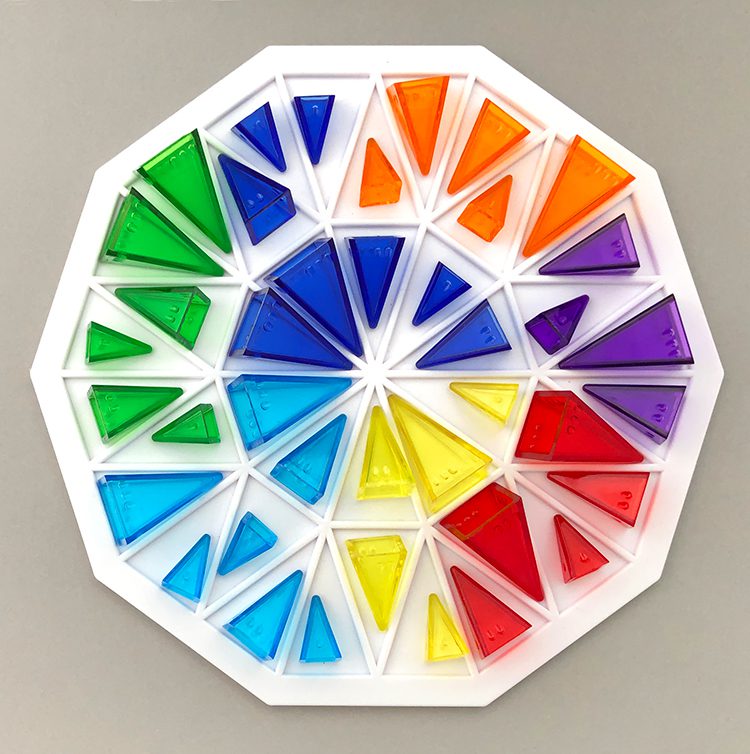
Give or Take
Components: Three Trios of any color for two players – if playing with more players, use one set of Trios per player, Pyramid Die
Number of Players: 2-10
Perhaps the simplest of the games in the Arcade, this is a game where, on each move, players will either give or take a Pyramid based on the roll of the Pyramid die. To win, you must have exactly three Pyramids in front of you, all of which must be the same size.
All Pyramids start the game to the side in an area known as the Bank. The active player rolls the Pyramid die, paying close attention to the size shown on the die. They then have many choices to choose from:
- Take a Pyramid of the size shown from the Bank.
- Take a Pyramid of the size shown from another player.
- Give a Pyramid of the size shown to another player.
- Give a Pyramid of the size shown to the Bank from their collection of Pyramids.
- Give a Pyramid of the size shown to the Bank from their opponent’s collection of Pyramids.
- In a game of more than two players, force one player to Give a Pyramid of the size shown to another player or Take a Pyramid of the size shown from another player.
If the Pyramid die rolls a side up with two Pyramids, you have the option of choosing which size you’d like to Give or Take with. However, to make the game even more interesting, you may also swap the two Pyramids shown.
Say you rolled a two-Pyramid, the Large and the Small. With the swap option you can choose to trade one of those two-sized Pyramids in your set of Pyramids, say the Small, for the other size. In this case, a Large. In a game with more than two players, you could also choose to force two other players to swap the corresponding sized Pyramids, providing they have the sizes available.
Since you can only win with three Pyramids of the same size you’ll need to work to keep your numbers low while forcing more and more Pyramids onto your opponent.

Hijinks
Components: Three Trios in any color, Hijinks board, Pyramid die
Number of Players: 2
A game of Hijinks starts with the three Trios in three Tree Stacks, one on each of the center squares in the middle of the Hijinks board. The goal of the game is to either (a) get three lone Pyramids of the same size on the row closest to you or (b) force your opponent to have all nine Pyramids on the row closest to them (their Home Row).
On a turn, players will roll the Pyramid die to determine which size of Pyramid they can move. That Pyramid is moved one space orthogonally. If there are additional Pyramids on top of the Pyramid you choose to move, they all go along for the ride. Pyramids can also be stacked, but only on top of Pyramids of the same size or larger.
Any Pyramid or stack of Pyramids that are moved into your opponent’s Home Row can then only be moved by your opponent.

Homeworlds
Components: Three Trios each of red, yellow, blue, and green
Number of Players: 2
Homeworlds is a game of interplanetary exploration and domination and one of my favorites. All you need to play are three sets of four Trios and a playing surface. This is such an Abstract game that there is no playing board!
Homeworlds is one of the most complex games in the Arcade and I could spend an entire review just detailing the rules and giving you an appreciation for the depth of choices and challenges the game presents. However, since this is one small piece of a long review, I’m going to limit myself to a fairly high-level overview.
The goal of Homeworlds is to either eliminate all of your opponent’s Starships or both stars in your opponent’s Homeworld. However, you can also lose the game if you have no ships left in your own Homeworld at the end of your turn.
The game starts with all of the Pyramids stacked according to size and color off to the side of the board. This is the common, limited Bank of Pyramids available to both players.
Pyramids in Homeworld represent both Star Systems and Spaceships. Star Systems are Pyramids that are standing upright; Spaceships are always laid down on their side. Your Spaceships will always be pointing away from you, towards your opponent.
As well, a Pyramid’s color denotes a special ability, each of which are crucial to the game.
- Green Pyramids allow you to Build new Spaceships. Newly built Spaceships can only be built in the same color as another one of your ships in that Star System and must be of the smallest size available in the Bank.
- Yellow allows you to Move to other Star Systems. You can take a Pyramid of your choice from the Bank and stand it upright to create a new Star System and then move one of your Starships there. Or, you can move to another existing Star System, regardless of how many other Starships (yours or your opponent’s) are already there.
- Red means you can Attack an opponent’s Spaceship. However, it can only attack a Spaceship that is smaller or the same size as the largest Spaceship you have in that Star System. However, this Attack power is not limited to only the red Spaceship. If you only have another, larger Spaceship in the same Star System you can use its size when you attack. Attacking doesn’t destroy Spaceships — instead, it converts an opponent’s Spaceship to one of your Spaceships. (You’ll do this by turning the successfully Attacked Spaceship around so it points at your opponent.)
- Blue enables you to Trade one of your ships with a differently colored Spaceship of the same size from the Bank.
These color properties extend not only to the Spaceships, but also to the Pyramids used to create a Star System.
The game starts with players taking two Pyramids of any color from the Bank of their choosing and stacking them in front of them. This creates the Binary Star System of their Homeworld. This is the first important decision you must make in the game, as the properties of your two Homeworld stars will dictate your early moves and, therefore, your initial strategy.
Players then take a third Large Pyramid and lay it on its side next to its Binary Homeworld. This is your first Spaceship.

Turns will typically consist of one basic action, that is, using the color property of any of your Spaceships in any Star System where they reside at the start of that turn. This means choosing Blue and Green for your Homeworld Binary Stars or including one of those colors as your first Spaceship is a good idea. You’ll immediately be able to start Building new Spaceships and Trading them for other colors to take advantage of the Move or Attack actions.
However, you can also take the Sacrifice Action. By returning one of your Spaceships to the Bank, you can take as many actions on that turn as there are pips on the Pyramid you sacrificed. (3 for a Large, 2 for a Medium, 1 for a Small).
When creating new Star Systems or moving to another Star System, it’s necessary to remember that like-sized Star Systems can never be connected. Spaceships can only move from one-sized Star System to a different-sized Star System
If at any point in a turn there are any four Pyramids of the same color, regardless of who they belong to (either four Spaceships or three Spaceships at a same-colored Star System — including a Homeworld) an Overpopulation Catastrophe occurs and all four Pyramids are returned to the Bank. If the Star was one of the four colors then all Spaceships are returned to the Bank as Spaceships cannot exist without a Star System to support them.
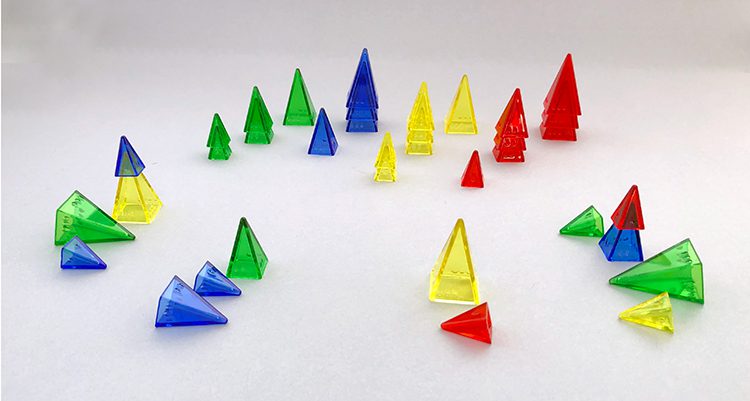
Without a game board to give some structure to Homeworlds the game can, to the casual observer, look like a chaotic scattering of Pyramids. Instead, Homeworlds is a deep strategy game that encourages the inner game designer in us all to push the limits of our preconceived expectations for games and gameplay.
Homeworlds is easily one of the most complex games in the Arcade and is one of Andy Looney’s favorites. Andy is so confident in his ability to play Homeworlds better than just about anyone that he’s publicly made the following promise: if you can beat Andy Looney at a game of Homeworlds, he will give you a medal. (Seriously! Check it out here.)Ice Dice
Components: One Trio of all five colors on the Color die (Cyan, Purple, Red, Green, Yellow) per player, Color die, Pyramid die
Number of Players: 2-3
Ice Dice is a press-your-luck game where you’re trying to collect three different monochrome Trees (a Large, Medium, and Small all of the same color) before your opponent does.
To start, place all of the Pyramids to the side (the Bank) stacked by color and size. On a turn, a player rolls both the Color die and Pyramid die to determine the color and size of the Pyramid they can move into the center space on the table (the Counter). (On Pyramid die rolls that show two different Pyramids, the player may choose which of the two sizes to claim.)
Pyramids are initially moved from the Bank to the Counter. The active player may choose to stop on that first roll or continue rolling. With each roll, an additional Pyramid gets moved from the Bank to the Counter until one of two things happen: either the player chooses to stop rolling and may claim all of the Pyramids from the Counter or the player rolls the same color on the Color die as a color in the Counter. The player has then Busted Out and all of the Pyramids in the Counter are returned to the Bank.
There are two other rules of note: if you roll a color and size of a Pyramid that is no longer available in the Bank, you get to steal it from an opponent’s Vault. (Even better, those stolen Pyramids are not returned if you Bust Out.) If you manage to push your luck and get a Pyramid of all five colors on the Color die in the Counter, you get to immediately move them into your Vault and continue rolling.
When someone wins they will likely have extra Pyramids in their Vault, either of colors other than their three single-color Trees or even of the colors of their Trees. Additional Pyramids don’t affect the winning conditions nor do they score any extra points.
The press-your-luck part of Ice Dice (which is suggested as an optional rule when playing with children) is part of what makes this game stand out from the others in the Arcade. This is a surprisingly fun little game that doesn’t take long to play — and one that you’ll likely want to play several times in a row, if only to beat those dice that made you bust out in the last game!

Ice Towers
Components: Three Pyramid Trios of a color per player
Number of Players: 2-10
Ice Towers is the game that Andy Looney created to mirror the fictional game he wrote about in the original short story that introduced the concept of the Pyramids.
In Ice Towers, each player is trying to have one of their Pyramids at the top (or “capping”) a tower of Pyramids.
As players build upon the various Pyramids, any Pyramid placed on top of another Pyramid must either be of the same size or smaller than the Pyramid under them.
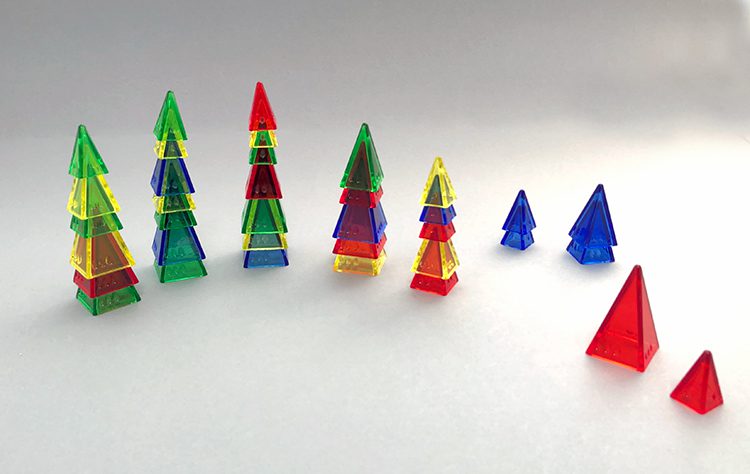
To add to the challenge there are two additional rules: Mining and Splitting. For Mining, if you do not have the capping Pyramid to a tower but have two or more of your Pyramids in that tower, you can choose to remove one of your Pyramids from the tower. The rest of the tower is reassembled as is and the mined Pyramid must be played immediately.
With Splitting, anytime you find two Pyramids of any color next to one another, you can split that tower in two. This means the tower is separated into two different towers at the point where the two matching colors touch.
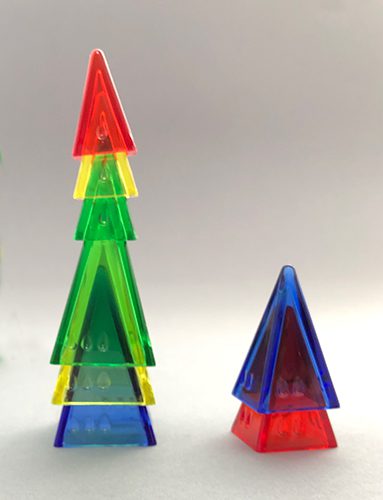
In this example, Yellow could mine either of its two pieces out of the tower to the left. If they took the small Pyramid they could use it to cap the smaller tower to the right. Green could also choose to split the tower to the left where the two Green Pyramids meet, thereby creating two separate towers.
When all legal moves have been made, players take the towers their Pyramids have capped and count out the Pyramids (Large = 3 points, Medium = 2 points, Small = 1 point).
My favorite thing about this game is that there are no turns. Everyone starts playing on an agreed upon signal and keeps making moves until the game ends. Having no set turns means you’re constantly watching all of the towers as they grow, split, and are mined out so you can do the same with other towers. It’s the partially-controlled chaos that makes for a fast, exciting game.Launchpad 23
Components: Two Trios of the five colors on the Color die (Yellow, Cyan Purple, Red, Green), Pyramid die, Color die, Launchpad 23 board
Number of Players: 2-4
Launchpad 23 is a game about building rockets — or rather, a stack of exactly five Pyramids of the same size in all five colors used in the game. Unfortunately, the Pyramids for those rockets come in random sizes and colors, making completing your rocket a challenge.
Players start by placing the Launchpad 23 board in the center of the table. Players take one full Trio of an available color and secretly choose one of the three sizes to start their game with. Everyone reveals their size at the same time, then claims one of the four corners for their own launchpad.
On a turn, players will roll both the Color die and the Pyramid die to determine two things: what new rocket part the Factory produces and how many actions you can take on that turn. The Color die indicates the color of the Pyramid produced (with Wild being the color of your choice) while the Pyramid die tells you the size. (If two sizes are shown on the Pyramid die, you get to choose.) By adding the number of pips shown on the Pyramid die, you’ll get your number of actions, with a Wild appearing on the Color die acting as a bonus move.
New rocket parts are placed on the center spot of the board. Often you’ll want to move that Pyramid — either because it’s a Pyramid you need so you’ll add it to your own rocket or to add it to your opponent’s rocket because it’s a Pyramid they don’t want and will have to waste an action getting rid of it. However, you can choose to leave the new Factory Pyramid where it is and move another Pyramid from the board. You cannot move Pyramids from another player’s launchpad, but you can add to their launchpad stack.
You can choose to move any Pyramid from your rocket, not just the one on top of the stack. You will undoubtedly do this often as other players will helpfully (not) add unnecessary, junk Pyramids to your otherwise fine rocket.
The first to construct a rocket of exactly five colors of the same size wins the game.
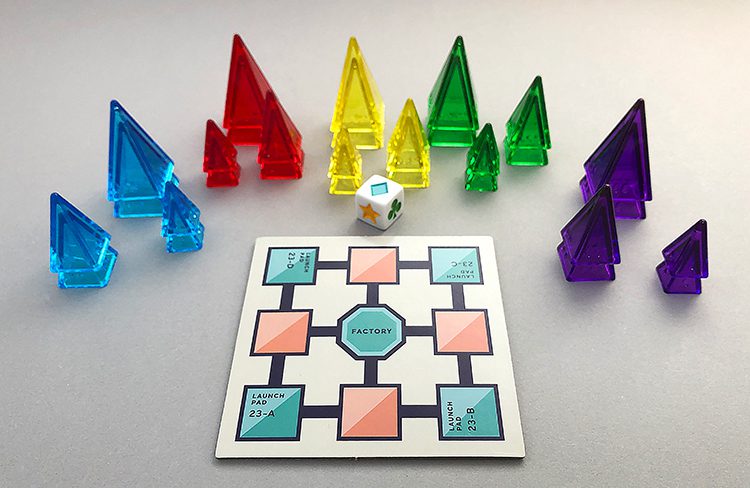
Honestly, you gotta love a game that includes that in the rules.
Looney Ludo
Components: One Trio of Pyramids per player that match the Looney Ludo boards in play, Treehouse die, two regular dice, four Looney Ludo boards for 2-4 players, with an additional board added each for five or six players.
Number of Players: 2-6
Players start by taking a monochrome Trio set and the matching color Looney Ludo board. The proper number of boards are placed side-by-side in the playing area, with all the Pyramids being mixed up and placed in such a way as to ensure no Pyramids are on the board of their own color.
The winner is the first player to get all of their Pyramids stacked in a Nest (Medium atop Small, Large atop Medium) in the center square of the board of your color. To do so, you’ll need to move not only your Pyramids on their starting boards, but move the boards around the playing area as well.
On a turn, a player will roll the two regular dice and the Treehouse die. You’ll take the larger of the two numbers on the regular dice as your number of Movement Points for the turn. Pyramids may only move from square to square on the Looney Ludo boards in the direction the arrows on each square indicate. As well, the number of pips on each Pyramid determines how many Movement Points it takes to move them one square: 3 for Larges, 2 for Mediums, 1 for Smalls.
The Treehouse die gives you special actions depending on what is rolled:
- Tip replaces whatever you rolled on the regular dice and gives you seven Movement Points.
- Typically, you can only move your own Pyramids, but Dig allows you to move any player’s Pyramids. Even better, you can split your Movement Points amongst multiple players’ Pyramids.
- Swap allows you to swap two of the boards for one another.
- Hop allows you to move one board to any other spot, changing its orientation along the way if you so choose. You cannot, however, leave any boards stranded from the other boards at the end of the Hop.
- Aim lets you rotate as many of the boards in play as you wish.
- You can take your pick of any of these options if you roll Wild.
Looney Ludo is a Pyramid game where the board(s) will be constantly changing with each move. Getting your Pyramids onto your color’s board will take careful use of your Movement Points and special Treehouse die options.

Lunar Invaders
Components: Three Trios of a single color per player, the two Lunar boards, nine dice
Number of Players: 2
The two circular boards are opposing moons, each with a Teleport Pad at their centers. To win, you’ll need to teleport enough of your Pyramids to your opponent’s moon to control their teleporter so you can teleport one of your Pyramids back to your home moon. Of course, your opponent is not only trying to do the same thing, but can attack your Pyramids or cause your teleporter to malfunction.
Each circular Lunar board is made up of nine spaces. Surrounding the central Teleport Pad are four Control Points (triangles connected only to the Factories) and four Factories (squares that are connected to both the Control Points and the Teleport Pad). At the start of the game, players take their three Smalls and Mediums and place the Smalls on two Control Points and the Factory directly across from them. The Mediums are placed on the Factory between the two Smalls and the two Control Points on either side of the Small.
As well, each player places their three Larges to the side as their Bank. Next to the Larges, each player takes four random dice. Dice in this game are not rolled, but are used as Malfunction Tokens, which I’ll get to in a moment.
One player takes the ninth die and hides it in one of their hands. The other player chooses a hand. If they guess correctly, they get the extra die/Malfunction Token and get to go second.

On a turn, players may take one of seven actions:
- You can Move one Pyramid of your color to any empty space it is connected to.
- If you occupy the two Control Points between an empty Factory on either moon, you may Build a new Pyramid on that Factory. You must, however, Build with the smallest Pyramid you have in your Bank.
- In order to Teleport from one moon to another, you must first occupy at least two Control Points on that moon. When Teleporting, you may land on any location on the other moon with the exception of the Teleport Pad. If you choose to land on a location occupied by an opponent’s Pyramid, the opponent’s Pyramid is destroyed and moved back into their Bank for potential future use.
- You may stack one of your Pyramids atop another Pyramid to Combine the two. This creates a single tower that is considered to be a single Pyramid with a value equal to the total number of pips of the stacked Pyramids.
- Similarly, you can choose to Divide a stack of Pyramids that you previously stacked — or use the Divide action to ‘split’ a larger Pyramid into two smaller Pyramids. (A Medium can be Divided into two Smalls; a Large can be Divided into a Medium and a Small).
- If you have two stacks of Pyramids adjacent to one another, you can Transfer one Pyramid from one of your stacks to the other.
- Throughout the game you will undoubtedly want to get rid of that pesky Pyramid belonging to your opponent so you can occupy it. To do so, you’ll Attack it. You can only Attack Pyramids of the same total size (remember, Combined stacks count as the full total of all their Pyramids) or smaller. If there is an empty space adjacent to the Attacked Pyramid, it moves into that space; if the adjacent spaces are occupied, the Attacked Pyramid is destroyed and returned to the Bank.
To thwart your opponent from simply overpowering you, Lunar Invaders provides you with at least four Malfunction Tokens (five to the player who goes second). As part of your opponent’s announced turn you can choose to stop whatever they’re planning on doing or, at least throw the proverbial wrench into the works.
There are four types of ways you can cause your opponent’s intended turn to Malfunction:
- You can spend one Malfunction Token to cause a Simple Stop. This causes any action (with the exception of one that involves the Teleporter) to be cancelled.
- When your opponent is Teleporting, they must state where on your moon they are Teleporting to. You can spend a single Malfunction Token to create a Targeting Error and force the Teleporting Pyramid to land on another location on your moon.
- If you have a Pyramid on your opponent’s Teleporter and they move to destroy your Pyramid before you can Teleport back to your moon, you can spend one Malfunction Token in what is described as Blocking Oblivion.
- If you truly want to stop your opponent from Teleporting a Pyramid from their Teleport Pad to your moon, you can choose to use two Malfunction Tokens to create a Total Shut Down. This halts your opponent’s action, leaving the Pyramid on their Teleport Pad.
Malfunction Tokens are the precious, limited resource in the game. Knowing when to allow potentially bad things to happen to save a Malfunction Token for something even worse is just as critical to winning the game as is knowing when to deploy a Malfunction Token.
Lunar Invaders started as a game Looney called Cosmic Coasters. That game was designed to be able to be played in bars, using drink coasters as the playing board. Cosmic Coasters used coins for game Pyramids. It won the Origins award for Best Abstract Board Game for 2001. Lunar Invaders is, according to Andy Looney, a “rebuild” of that game using Pyramids and Malfunction Tokens. Personally, I feel there needs to be more games that can be played on drink coasters. (Like Skull, for instance!)Martian Chess
Components: Three Trios of any color per player, Martian Chessboard
Number of Players: 2
First, forget most of what you know about the standard game of Chess. While you’re at it, forget about the concept of the pieces that start on your side of the board always remaining Your pieces. Oh, and disregard the colors as well as the term ‘Checkmate.’
A game of Martian Chess starts with all nine Pyramids set up in a square formation in the lower right corner of your side of the Martian Chessboard. The Larges are in the corner space and the two spaces orthogonally connected; the Mediums form a diagonal line one space away from each Large; the Smalls complete the square in the upper left corner.

Smalls are known as Pawns. They move one diagonal square at a time.
Mediums are Drones. They can move one or two squares orthogonally from their current position including backwards.
Larges are Queens and move like Queens in standard Chess: as far as they like in a straight line, either orthogonally or diagonally.
The wonderful twist to Martian Chess has to do with the dividing line between the two boards. Known as the Canal, one of your Pyramids must cross the Canal to capture your opponent’s Pyramid. However, as soon as it lands on their side of the board, that Pyramid becomes their Pyramid.
After capturing a Pyramid, you set it aside in a captured pile on your side of the board.
Martian Chess also allows for stacking or, as the game calls it, Field Promotions. If, for instance, your opponent has captured all of your Drones you can, on a turn, stack two Pawns together. These two Pawns are then exchanged for one of the Drones in your opponent’s captured pile. Similarly, if all of your Queens have been captured, you can stack a Pawn and a Drone and then exchange it for a Queen.
The game ends when one player’s board has been emptied of Pyramids.
Winning a game of Martian Chess comes down to who has earned the most points from captured pieces (Pawns = 1 point; Drones = 2 points; Queens = 3 points).
Martian Chess was the second game Looney created for the Pyramids. It can be a difficult game to wrap your head around, with Pyramids trading ownership as soon as they capture a Pyramid across the Canal. That twist to the game, however, is what makes it so fun to play. Watching the initial confusion turn into a genuine Aha! moment for a new player is great to see.Martian Chess can also be played by 3 or 4 players, but you’ll need special boards for more than 2 players. Designs can be found online for the warped-looking 3 player version, while a standard Chess board can be used for the 4 player version.
Petal Battle
Components: Three Trios of a single color plus one Trio of a neutral color per player, Daisy board
Number of Players: 2
In Petal Battle, players are insects using their Pyramids to take control of five adjacent petals of a contested daisy.
On a turn you can take one of five actions:
- Take one of your Smalls and Spawn by placing it on the Daisy board on either side of one of your Larges.
- Take a Small or Medium Pyramid and Grow it to the next larger size.
- Move a Pyramid by Sliding it into a space next to it or Flipping it onto the petal directly opposite the one it’s currently on.
- Slide or Flip a Pyramid onto a petal occupied by your opponent’s Pyramid that is either the same size or smaller and Bump it into an empty space next to it. If that space isn’t empty, you Squish the Pyramid. If you Squish a Pyramid of the same size, the Squished Pyramid shrinks down to the next smallest size. If your Pyramid is larger, the Squished Pyramid is removed from the board.
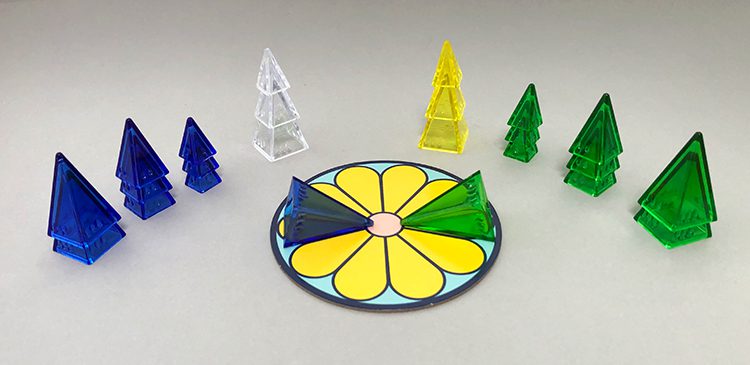
Petal Battle is played in three turn segments and the way those segments are determined is what makes Petal Battle unique. Remember that neutral Trio each player has? The number of pips on each Pyramid determines the number of actions you can take in a segment. Players secretly arrange their neutral Pyramids in the turn order they want their number of actions to occur. Do you put your 3 pip Pyramid (Large) on top to take three actions on your first turn or do you put the 1 pip (Small) on top and save your 3 pip for your second move?
Petri Dish
Components: Three Trios of a single color per player, all three Lightning dice, Wheel board, the Color die to keep track of an uncommon bonus action.
Number of Players: 2-5
In Petri Dish, you’re playing as bacteria working to dominate the closed structure of a Petri Dish. You’ll win by either destroying all other players’ Pyramids (bacterium) or by getting all of your Pyramids on the board.
The Wheel board can be seen as being divided into ten separate wedges, with a wedge consisting of three triangles along a flat edge of the board and a single wedge that touches the center of the board on top of the wedge’s base. Players start the game with two Smalls on either side of a Large at the base and a Medium on top. The overall starting board configuration will depend on the number of players.
On a turn, a player will roll all three Lightning dice. These will allow you to:
- Divide one of your Medium or Large Pyramids into two Pyramids of the next smaller size. One of the smaller Pyramids goes in the section where the original, larger Pyramid was. The other Pyramids go into an empty, adjacent space.
- Take a Small or a Medium Pyramid and Grow it to the next larger size Pyramid.
- Move a Pyramid either to an empty adjacent space next to where the Pyramid started or to any empty space within the same contiguous group of your Pyramids. This oozing like movement is officially known as “Splorfing.”
- Reduce a Large or Medium down one size or simply Zap any opponent’s Small Pyramid completely off the board.
- Infect an opponent’s Pyramid and replace it with one of your own of the same size. To do so, the Pyramids must be adjacent to one another.
- Choose any of the other five actions if the Wild icon appears.
If you roll doubles, one of the two becomes Wild. If you roll triples, two become Wild and you get an extra bonus action.
Petri Dish is a player elimination game. While the official rules state it can be played with up to 10 players, that many players make for a completely filled board and can mean it’s possible for someone to be knocked out of the game early. (The only way to expand is by eliminating other players’ pieces.) Keeping the player count down to 3-5 makes for a more evenly spaced, and therefore more enjoyable, game for everyone.Pharaoh
Components: One Trio of a single color for each player, Volcano board, two standard dice
Number of Players: 2-4
Pharaoh is a game where you seek to control the three central squares of the Volcano board. Depending on the numbers of players, those squares are either the three that run horizontal to the players (2 players); any three squares in a row that form a cross through the center square (3 players); any three squares that form a cross or an X through the center square (4 players).
The game starts with each player’s Pyramids ready to enter the board. Movements are made orthogonally, with Pyramids never jumping over or capping another Pyramid. To make any movements, you must roll the two dice.
The number of movements on a turn will be equal to the higher of the two dice rolled. You’ll take that number and decide how to use it amongst your three Pyramids: a Small takes 1 to move, a Medium takes 2, and a Large 3. Your rolled number can also be split amongst your Pyramids. In this way, if you rolled a 6, you could move a Large twice, a Small six times, or a Large one space as well as a Small and Medium one space.
If you move one of your Pyramids into a space occupied by an opponent’s Pyramid that is the same size or smaller than your Pyramid, their Pyramid is removed from the board. Smaller Pyramids cannot move into a space occupied by an opponent’s Pyramid that is larger.
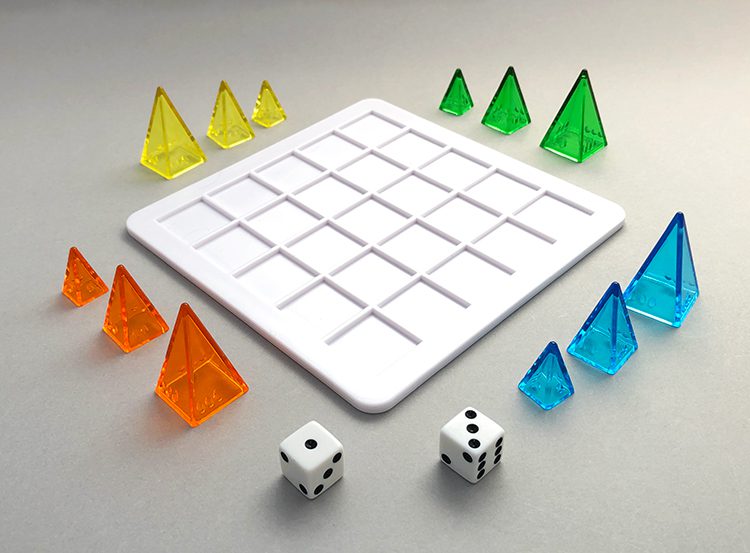
Powerhouse
Components: Three Trios of five different colors, three of any dice, the Drawstring bag
Number of Players: 2-5
In Powerhouse you are trying to be the first player to create a clean and sustainable power source. This is done by collecting exactly five Pyramids of a single size in all five colors.
Start the game by mixing all of the Pyramids in the Drawstring bag. Then add the three dice. On each turn a player takes the bag and reaches in without looking, draws a single Pyramid out, and places it on the table. Players can feel around for a specific size, but no peeking is allowed. (Think: Tajuto)
You’ll want to line up your Pyramids (your Power Grid) in front of you and arrange them by color. Not only will this help to see who is closest to winning, but it will also show what other Reactions may take place before a player’s turn is over.
Here are two examples of Reactions to your Power Grid may trigger:
- If you have two Pyramids of the same size and color you have a Reactor. This means you must give one of those Pyramids to an opponent and end your turn or exchange it for any one of their Pyramids.
- If you collect a monochrome Trio you have a Battery. Batteries allow you to return any one of your Battery Pyramids to the bag and trade another Battery Pyramid with another player for any one of their Pyramids.
There may come a point where you have a Powerhouse, but also have extra Pyramids. This is considered to be a Dirty Powerhouse and you must ‘clean’ it, or get rid of all of the unwanted Pyramids before winning. The five Pyramids that make up your Powerhouse, however, are safe from exchanges.
The only thing that can affect a Powerhouse is a Meltdown. Remember those three dice that were added to the bag? If you think someone is getting too close to winning the game, you can pull out one of the dice, triggering a Meltdown. This causes all players to return any one Pyramid back to the bag. When the second die is pulled from the bag all players must return two Pyramids to the bag. The third die requires three Pyramids to be returned.

Pyramid-Sham-Bo
Components: One Trio of each color per player
Number of Players: 2-10
This is a tournament-style Rock-Paper-Scissors party game with Pyramids being used as scoring tokens.
Each player has three Pyramids of a single color. Throughout the game, it is possible that players may trade Pyramids to ‘make change’ for other players.
On a turn, a player challenges any other player in Rock-Paper-Scissors. The loser must give one of their three Pyramids to the winner as follows: if a player loses in the first round, they give up a Pyramid worth one pip (Small); if players tie (for instance, by both showing Paper), the loser will need to surrender a Pyramid worth two pips (either a Medium or two Small); if players tie for a second time, the ‘cost’ of losing increases to three pips worth of Pyramids, etc.
When a player is eliminated, all of their former Pyramids are removed from the game.
The winner is the only player not eliminated.
Treehouse
Components: One Pyramid Trio per player, Treehouse die, a Neutral Pyramid Trio
Number of Players: 2-10
The game starts with each player’s Trio stacked in a Tree formation in front of them. In the center of the table are the House’s Pyramids. These three Neutral Pyramids are lined up in a row with the Small standing in the center, the Large on one side, laying down and pointing away from the Small, and the Medium on the other side of the Small, also laying down and pointing away from the Small.
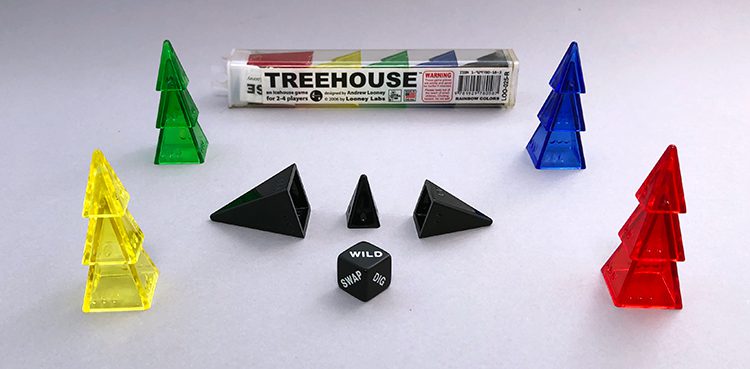
The goal of the game is to be the first player to get your Trio of Pyramids to mirror the formation of the House’s Pyramids. (That orientation will vary depending on your place around the table.)
A roll of the Treehouse die determines your action on your turn. Those actions are:
- Aim by reorienting a single Pyramid. Since all Pyramids must remain in a single row, the only directions a Pyramid can be Aimed are to the left, to the right, or standing upwards. This can only be done to solitary Pyramids, not those in a stack.
- Take an upright Pyramid and Tip it over on its side, pointing it either to the right or the left (your choice). If you’re Tipping a stack, you must Tip the entire stack. As well, each of the stacked Pyramids separate from one another and all point in the direction in which they were Tipped. (Pyramids lying on their side cannot be Tipped upward.)
- A Pyramid that is lying on its side can Dig in the direction it’s pointed and then ‘resurface’, standing upright, either in place or at any other place in your row. This can also result in a Pyramid ‘resurfacing’ under another standing Pyramid at which point the Pyramid used to Dig is stacked underneath the other standing Pyramid.
- A Hop allows any standing Pyramid to jump to another location in your row of Pyramids. A Hop can be made by a single Pyramid, a stack, or part of a stack.
- Swap allows you to change the order of any two Pyramids. The Pyramids’ orientation is maintained, unless you’re swapping a Pyramid lying on its side into a stack. Then the swapped Pyramid stands up as part of the stack.
- Wild allows you to perform any of the above actions with one important addition: you can choose to perform any of those actions on either your Trio or the one belonging to the House.
That last action of the Wild side of the Treehouse die is where you need to decide if using the Wild action on your own Pyramids is wiser than playing a Wild action on the House’s set of Pyramids. While you can never use a Wild action on an opponent’s Trio, you can change any part of the House’s Pyramids to cause problems for an opponent who is closer to winning than you are!
Twin Win
Components: Five Trios each a different color, Twin Win board, 10 Twin Win cards in the colors chosen for the game
Number of Players: 2-3
To start the game, mix all of the Pyramids together and stack them into five Tree formations, making sure each Tree is made up of three different colors. Place one at the center of the Twin Win board and then each of the other four Trees on a space with an arrow pointing out from the center space.
Then shuffle the Twin Win deck and deal two cards out to each player. These two cards will show either a solid color Tree or Nest of one of the five colors used in the game. These are your two secret winning conditions. Complete either one first and you win.
Players must take two moves per turn. Moving Pyramids is the most likely move since shifting Pyramids is the only way to get you to one of your secret goals. However, you may only move the topmost Pyramid in a stack — but you can stack a Pyramid of any size on top of any other-sized Pyramid. Arrows on the board show the allowable directions Pyramids can be moved in.
Your other possible move would be to swap out one or both of your current goals for new ones. Each swap is considered to be a turn.
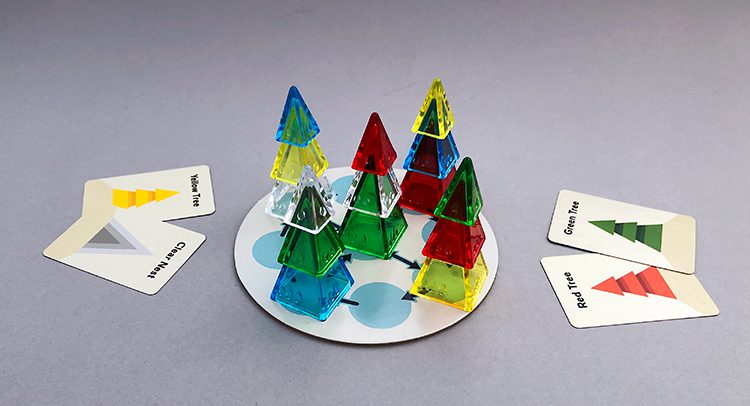
Verticality
Components: Up to all 90 Pyramids, Pyramid Die, Zark City playing cards
Number of Players: 1-5+
Verticality is a dexterity game with players each trying to build the tallest tower.
A roll of the Pyramid die tells you which of the three sizes of Pyramids you’ll each use as the girders of your vertical tower for that turn. Each player will take three of that rolled size and set them upright such that each Pyramid is touching another Pyramid. A Zark City card is then placed on top of the three Pyramids. The next player rolls the Pyramid die and players take three of whatever size Pyramid is rolled and, with a single hand, place those Pyramids on their tower’s previously laid Zark card such that each Pyramid is touching another Pyramid. Then a Zark City card is placed atop those Pyramids.
Play continues until all but one tower has fallen, with the remaining player being named the winner.
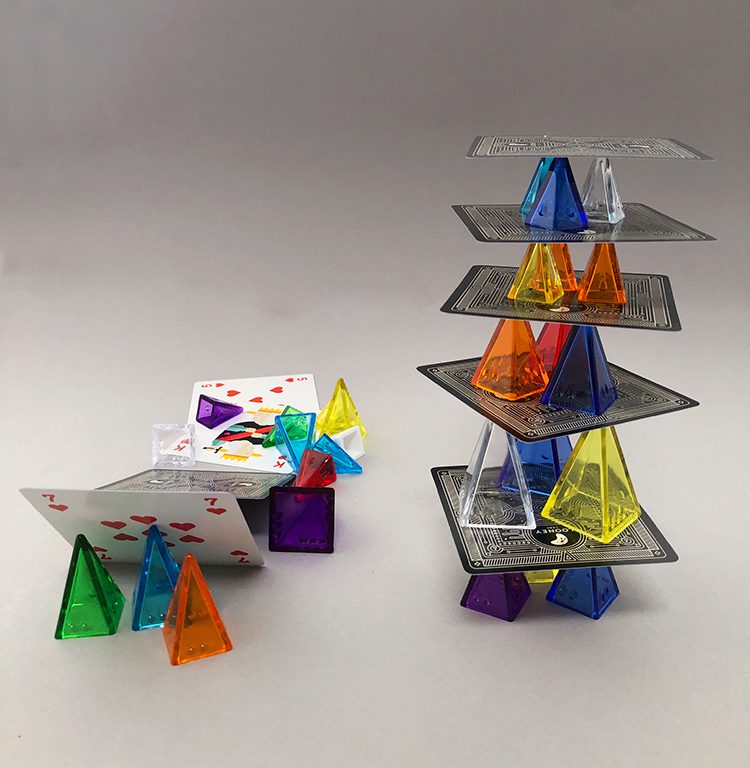
Volcano
Components: All 90 Pyramids except the Medium and Large black and whites, Volcano board
Number of Players: 2-3
Volcano is a beautiful Abstract strategy game that exemplifies, for me, the best of what the Pyramids can be.
I mean, honestly, just look at this starting board.

This is a game of erupting volcanoes, as represented by the Pyramids. You’ll trigger eruptions on each turn, looking to claim Pyramids. The winner is the first person to collect either three monochrome Trios or five mixed-color Trios.
Start by placing all of the translucent Pyramids in Nests, that is Medium atop Small, Large atop Medium randomly around the board. No two Nests of the same color should be adjacent to one another and the center square is left vacant.
The three Small Black Pyramids go atop the Red Nests; the three Small White Pyramids go atop the Orange Nests.
On a turn, players will move the Small Black and/or White Pyramids, known as Caps, in any direction, to the top of another Nest. Providing there is not another Cap on a Nest next to the newly Capped Nest in the direction the Cap was moved towards, an Eruption is caused. The Nest uncovered by the moved Cap then Erupts by having the Large Pyramid ‘jump’ — or Flow — over the newly Capped Nest and land on the next Nest in line. Following that, the Medium Pyramid Flows over the newly Capped Pyramid and the Nest that had the Large moved on top of it, landing on the next Nest. And if it’s possible, the Small Flows over all three and lands atop the next Nest in line. If a Pyramid Flows to the edge of the board, the turn ends.
Caps can only be moved from one Nest to a Nest next to it, either orthogonally or diagonally.
Whenever an Erupting Pyramid lands on top of another Pyramid of the same size, the Erupting Pyramid is claimed by the player who caused the Eruption.
It is possible to move a Cap without causing an Eruption (either by moving it atop a Nest at the edge of the board or atop a Capped Nest with another Cap on the Nest in a straight line of movement). When this occurs, you can either choose to move another Cap or continue moving the first Cap as many times as you like, providing it does not cause an Eruption. This can be a powerful strategic move when done right.
While Caps cannot be stacked it is possible that Eruptions will cause oddly shaped stacks — part Tree, part Nest. This is fine.
The last extra rule is the Power Play. Before creating an Eruption on the board a player can choose to return one of their captured Pyramids to the playing field on the location of the player’s choosing. This can be used to create capturing opportunities otherwise not possible, or as a defensive move to block the other player from making a capture.
Volcano is as beautiful a game as it is a brain-burner to play. It will take a while to understand the Capping strategy and learn how to plan out your moves to capture the Pyramids you’ll need to win, but what a fun learning curve it is..
Volcano was created by Andy’s wife Kristin Looney, the owner of Looney Labs. It is also one of my favorite games in the Arcade. This is partly because it’s so beautiful to look at, but also because the gameplay is so simple and elegant, yet so difficult to wrap my head around. When I do make a good move, I feel like I’ve really accomplished something.World War 5
Components: Three Trios of a color per player, three standard dice, World War 5 board
Number of Players: 2-4
I like to think of World War 5 as a shorter, more strategic version of Risk. Games take from 10-15 minutes and require you to balance protecting your home continent while successfully invading another continent.
The world is divided into six continents, each defined by a different color on the playing board. Players each start with three sets of Trios in the color of their chosen continent and place one Pyramid of each size in the three sections of their continent.
On a turn, players may do take one of four actions:
- Grow the size of a Pyramid on your home continent by swapping a smaller size out for the next larger size. Since larger sizes mean more dice to roll during conflicts, it’s a good idea to invade with larger Pyramids.
- Build by placing a Small Pyramid on an empty area of your home continent.
- Move one of your Pyramids to an empty territory on another continent through an available connecting line. (While all continents have connecting lines to each other continent, only certain sections of a continent connect to certain areas of another continent.)
- Enter into direct combat with an opponent by Invading — entering a connected section of a continent occupied by an opponent’s Pyramid.
As with Risk, combat is at the heart of World War 5. Combat begins with one player taking a Pyramid and laying it down, pointed at their opponent’s Pyramid. The players then count out the number of pips on the combatting Pyramids (3 for Large; 2 for Medium; 1 for Small) and roll a corresponding number of dice. If the Defender wins or ties, the battle is over and nothing changes. If the Attacker wins, the loser must retreat into an adjoining territory of their choice, either an open territory on the same continent or on another continent through the lines of connection. The winning attacker then moves into the abandoned territory.
A player wins when they conquer all three territories of another continent — providing they still have at least one of their Pyramids in their home continent. Alternatively, a player can win by eliminating all of the other players’ Pyramids from their home continents. (In games of more than two players, any player whose Pyramids are wiped off of their home continent is immediately eliminated from the game.)
I am, admittedly, not a fan of Risk (much to the disappointment of my weekly gaming group) but I find World War 5 a good compromise. The battles are unfortunately dice-driven, but you have some control over the numbers based on how you build and deploy your pieces. And, it’s a whole lot shorter!Zark City
Components: Three Trios of one color per player, Zark City playing cards
Number of Players: 2-5
Zark City is part card game, part Pyramid domination game. In mash-up terms, it’s a Zark Cardyramids game. Or something like that.
Players start with all nine of their Pyramids in a supply as their personal Bank. The square Zark City cards are shuffled then dealt, three cards per player.
The game board will be created throughout the game by playing the numbered cards from your hand. To win, you will need to be the only player to have Pyramids on three adjacent cards (either in a straight line or in an “L” shape) that are either three of a kind (i.e., three 9s) or a suited run (i.e. the 7, 8, and 9 of Stars — remember, the Zark deck has five suits).
Meanwhile, not only will your opponent be trying to do the same thing, but they’ll also actively be trying to stop you by interfering with your Pyramids.
All players will start by playing one card from their hand and placing a Small Pyramid on the card. Each new turn starts with a player drawing a new card from the Zark card deck. From there, players have various options they can choose from on a turn:
- Spawn by adding a Pyramid to a card you already occupy, that is, currently have a Pyramid of your color on.
- Grow a Pyramid by replacing it with the next larger size Pyramid from your Bank.
- You can Build onto the board by playing a card from your hand next to a card you have a Pyramid on.
- Take one of your Pyramids and Move it onto an adjacent card.
- If there is an annoying Pyramid next to a card you occupy that you’d like to get rid of, you can Demolish it by playing face cards from your hand equal to the pips on the Pyramid you wish to Demolish. For the Pyramids, Small = 1, Medium = 2, Large = 3. For the face cards, Jacks and Aces = 1, Queens = 2, Kings = 3.
- Alternatively, instead of Demolishing a Pyramid, you can Convert an opponent’s Pyramid to a Pyramid of your color of the same size or smaller.
- Instead of spending your Ace on a Demolish or Convert move, you could also use it to Fly a card that you occupy (and all of the Pyramids on that card) to anywhere else on the board, provided the card ‘lands’ adjacent to another card.
- If all of your Pyramids have been removed from the board, you may Build a new card on the board and place a Small on that card, as if taking your first move late in the game.
- Sometimes you simply won’t have the cards you want in your hand. When that happens, after you’ve drawn a card to start your turn you can elect to Draw three more cards into your hand. However, you must always end with six cards in your hand at most. If you’ve drawn up to more than six, you’ll need to discard down to six cards before ending your turn.
Growing your Pyramids helps to make it harder for your opponent to Demolish or Convert your Pyramids. Knowing when to Grow smaller Pyramids depends on how the board is shaping up, especially when you remember you can’t Grow a Pyramid if you don’t have the necessary Pyramid in your Bank.
Given how quickly the board grows, the more people you have playing, the larger your gaming table needs to be!
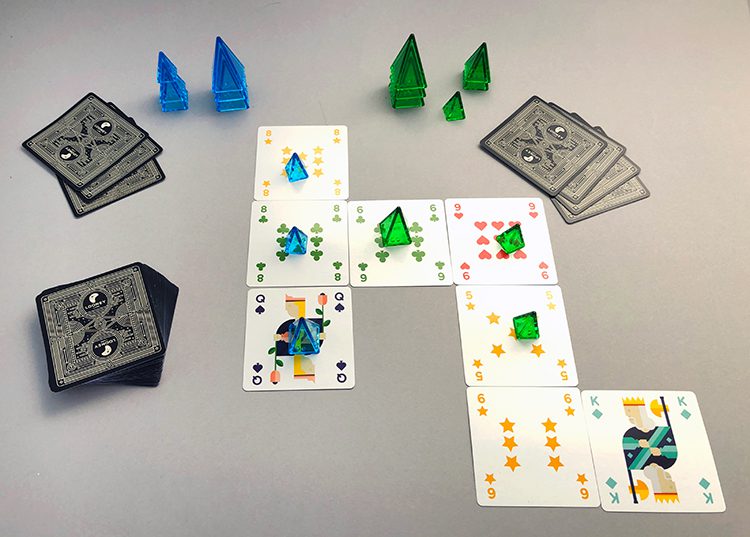
However, I must admit that I am disappointed about one thing with Zark City. In Launchpad 23 the rules state you must make the sound of a rocket blasting off as you launch in slowly up to indicate you have won. Why aren’t players required to make whoooshing flying noises when they choose to Fly a card?
But Wait…There’s More!
I can already hear some of you saying, “Twenty-two games? Is that all?”
Fear not! At the end of Andy Looney’s extensive rule book is a listing of 22 additional games selected by diehard Pyramid fans. Each game is given a quick paragraph summary with the full rules being online at the Looney Labs website. Some of these games can be played with the components in Pyramid Arcade; some will require either additional Pyramids or items to play.
But Wait…There’s Even More!
People have been playing with Pyramid pieces for over 20 years. In that time, lots of Pyramid fans have created their own games using the Pyramids.
There is a curated collection of over 500 of the best games over at IceHouse.org. Games can be searched for by the number of colors for given Trios, by player count, by theme, style, and mechanics.
Watch Them Played
If you’re a visual learner like me, YouTube is your friend. Looney Labs have their own channel with tutorials for some of the games and a separate playlist where Andy and his wife Kristin (also the President of Looney Labs), play each of the games in the Arcade. (Homeworld is an exception to this. Looney Labs has an entire series of videos called Homeworlds Theater where notable Homeworlds games are replayed from game notations.)
Final Thoughts
The 22 games in the Pyramid Arcade rule book, along with the 22 additional games mentioned at the end of the rules, should give you an idea of just how versatile the Pyramids are as a gaming system.
I’ve been a serious fan of the Pyramids going back to the days when they were originally called Icehouse Pieces (for more on Pyramid Arcade and its history, check out my Games We Love Looney Pyramids article). There are just so many possibilities for games using these pieces, with games able to be played with minimal boards or no board at all! They’re small, easy to carry around, and lend themselves to games of all types.
Pyramid Arcade showcases a wide variety of games: games using dice, games that are purely Abstract in nature, games to be played alone, games for two players, and games for crowds. There are brain-burning games for serious gamers, lighter party games for new players, and plenty of games in between.
The Arcade, therefore, is a cross section of the possibilities Andy Looney’s Pyramids have to offer. There really is something here for just about everybody!


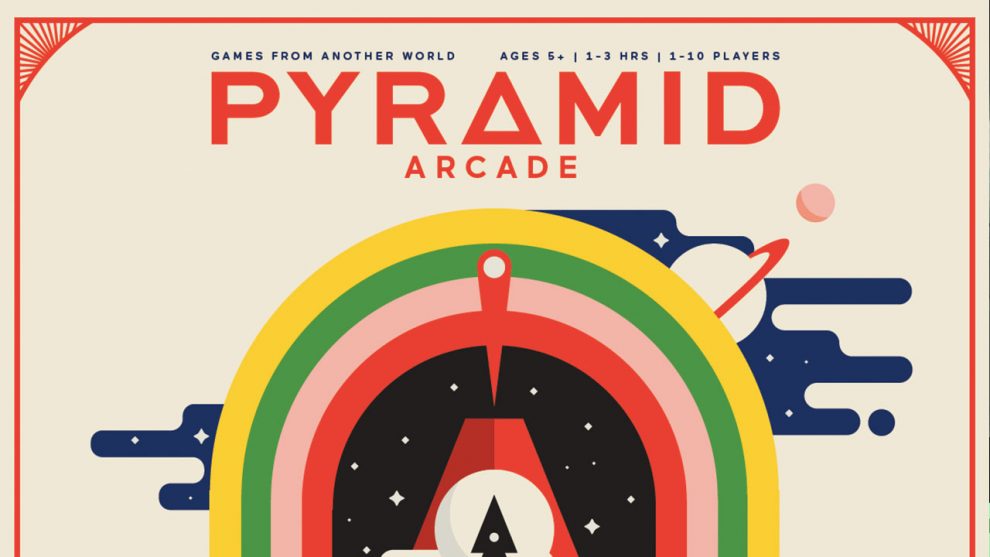









This was an incredibly well-written in-depth yet with easily digestable chunks review. I was particularly taken with the suggestion of requiring a ‘whooshing’ sound be made when flying a card in Zark City. I will be promoting this idea (with credit given to you, of course).
A next novel, you say? Gonna have to go look for your prior ponderings. I like everything about your bio, too. Signing up to see more of your musings, thanks for the fantastically fun review!
Dr. Leila “I’m the real McCoy” Zucker
–Looney Pyramids Starship Captain
–Homeworlds medal winner #12
–ER physician
Hi Leila! Thanks for reading and commenting. You’re a Homeworlds Medal Winner?!?! That is a very impressive line on your otherwise already impressive CV.
I think I’ve linked to my middle grade Steampunk Fantasy book in my full bio, but you can find the (free) serialized podcast of the book at https://PowersBeyondTheirSteam.com.
Thanks for writing. It’s great to hear from a Starship Captain!
Great review with lots of pics that make the games come alive! I’m a Homeworlds Fan, but during GenCon20 I couldn’t win playing Andy. But I resisted for more than an hour! It was a nail-biting experience, and reminded me when I was a beginning Go player. I’ve written a book on Homeworlds that includes more than 14 variants worth checking out. See https://boardgamegeek.com/filepage/193248/play-homeworlds-rules-strategies-variants.
My next book project is collecting 10+ abstract strategy games you can play with the Homeworlds Set (which is just a small part of the Pyramid Arcade, see http://store.looneylabs.com/Homeworlds). Perhaps you think the Pyramid Arcade is too steep of an investment for a system you don’t know yet. So, why not study the rules of my Starship Captain list? See https://www.icehousegames.org/wiki/index.php?title=User:Cuc. It contains 15 games playable with the Homeworlds Set (that’s “almost” 22, hehe). You can’t go wrong with this set!